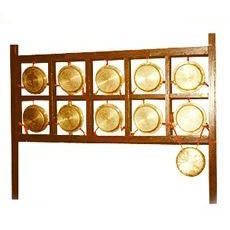yunluo overview

Yunluo (pinyin: yún luó), which appeared in the Tang Dynasty and became popular in the Yuan Dynasty, is a percussion instrument used by the Han, Tibetan, Mongolian, Manchu, Naxi, Bai, Yi and other ethnic groups. The ancient name Yunzhe, also known as Yun'ao, is also known as Jiuyin Gong in the folk. Tibetans call it Dingdong and Dingdang. It is a musical instrument that can play tunes among gongs. Often used in folk music, local opera and temple music. Popular in the vast areas of Inner Mongolia, Yunnan, Tibet and Han nationality. And spread to other parts of East Asia, there is a record in the ancient "Yuan Shi" Li and Music Records, also called Yun'ao, or Jiuyin Gong, Jiuyun Gong. It can still be seen in folk music such as Nanguan and Jufan.
Cloud gongs are made up of gongs of the same size but different thicknesses, suspended on a wooden frame by three ropes, and played by percussion with a mallet. The number of gongs varies, including ten, 13, 14, 15, 24, 38, etc., and the hanging method is not fixed. There are two horizontal rows, three rows, etc., and the wooden frame has a frame and a handle. The hand-held one can be played with two hammers with both hands. The pitch and range are also different.
Our ancestors choreographed small gongs with different pitches very early and used them in musical practice. In the Song Dynasty painter Su Hanchen's "Trademan Picture", a merchantman hangs several musical instruments, one of which is a ten-faced cloud gong. In the Yuan Dynasty more than 600 years ago, cloud gongs were not only popular among the people, but also used in court banquets. Made of bronze, it is a small gong thirteen, the same wooden frame, with a long handle under it, the left hand holds it, and the right hand hits it with a small mallet." This is also the earliest record found in the literature.
- Pinyin:yún luó
- Classification:percussion
- popular area:Inner Mongolia, Yunnan
- time of appearance:Tang Dynasty
overview of other similar instruments
- sanyanxiao overview
- Daguangxian overview
- Leiqin overview
- hahao overview
- yandundagu overview
- Han Xiaozheng overview
- Fang Xiang overview
- guanzi overview
- zhuqin (Dao Qin) overview
- zhuiqin overview
- bangzi overview
- three-stringed piano overview
- Gehu overview
- xiao overview
- xiaokonghou overview
- Konghou overview
- Sheng overview
- suona overview
- hulusi overview
- gushao overview
 渝公网安备 50010702504639号
渝公网安备 50010702504639号